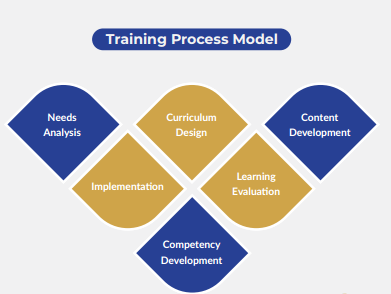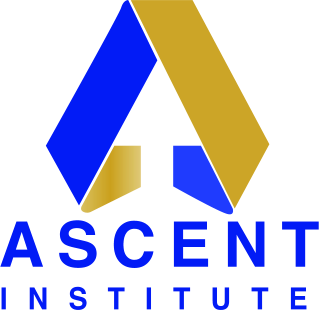PROCESS Model
At Ascent Institute we use the following training model shown in the diagram below:-

COMPETENCY DEVELOPMENT
NEEDS ANALYSIS
CURRICULUM DESIGN
CONTENT DEVELOPMENT
IMPLEMENTATION
LEARNING EVALUATION
COMPETENCY DEVELOPMENT
Competency development is the starting point in creating an effective training program. It defines the objectives of a learning initiative and specifically describes what the desired performance behaviour should look like and sound like. It projects what the desired learning results should be. In defining performance competencies, we focus extensively on gaining consensus among all stakeholders in order to ensure that learners clearly understand what is expected of them and to minimize any future inconsistencies in the coaching and evaluation of performance behaviours.
NEEDS ANALYSIS
Needs analysis is an examination of the existing need for training within an organization. It compares the desired performance level (determined through competency development) to the current performance level to identify the performance gap(s). Needs analysis determines what a proposed training initiative content should be and sets the stage for the design and development of the program curriculum.
CURRICULUM DESIGN
The curriculum design phase of training focuses on creating the blueprint for the proposed performance improvement initiative. The fundamental function of curriculum design is the determination of the format of the individual elements that will comprise the proposed training as well as their interrelationship. Basic format options for training include instructor-led formal classroom training, learner-directed manual-based or computer, mediated training, facilitated group discussions as well blended learning initiatives which involve various combinations of the above.
Curriculum design includes the selection of appropriate media (audio or video), materials (computers, manuals, learning aids, etc.), instructional techniques (lecture, simulation, role play) and learning transfer methods. It also includes the development of the training plan or agenda.
Our approach at Ascent Institute is to work with Clients to design curricula that best meets the organizational need. To accomplish this, we take into account the needs, attitudes and preferences of learners and work to leverage the organizations learning resources.
CONTENT DEVELOPMENT
Training content development consists of acquisition and/or creation of each of the training program components identified in the curriculum design phase. Curriculum development often involves working with subject matter experts from within and/or outside the organization to capture specialized knowledge for inclusion of the training content.
IMPLEMENTATION
All the aspects of a training program come together during the implementation phase. The implementation phase is the point of impact for all of the time and effort devoted to the development of a training program. While the implementation phase must be well-planned, appropriately structured and practiced, it must also allow for adaptation to special situations that arise during content delivery. No two groups of learners have the same training needs, learning styles or motivation. Hence, our skillful trainers and are continually on the watch for issues that call for modifications in the training implementation plan
LEARNING EVALUATION
Learning evaluations help measure the value and effectiveness of a training program. Learning evaluations use assessment tools to provide data for the evaluation. At Ascent we can evaluate the participants' reaction to the training program, measure the extent to which the learning objectives of a training initiative have been, the degree to which participants have actually learned to do what they were expected to learn to do and finally assess training in terms of business results, i.e., return on investment increased sales, increased production or improved quality.

